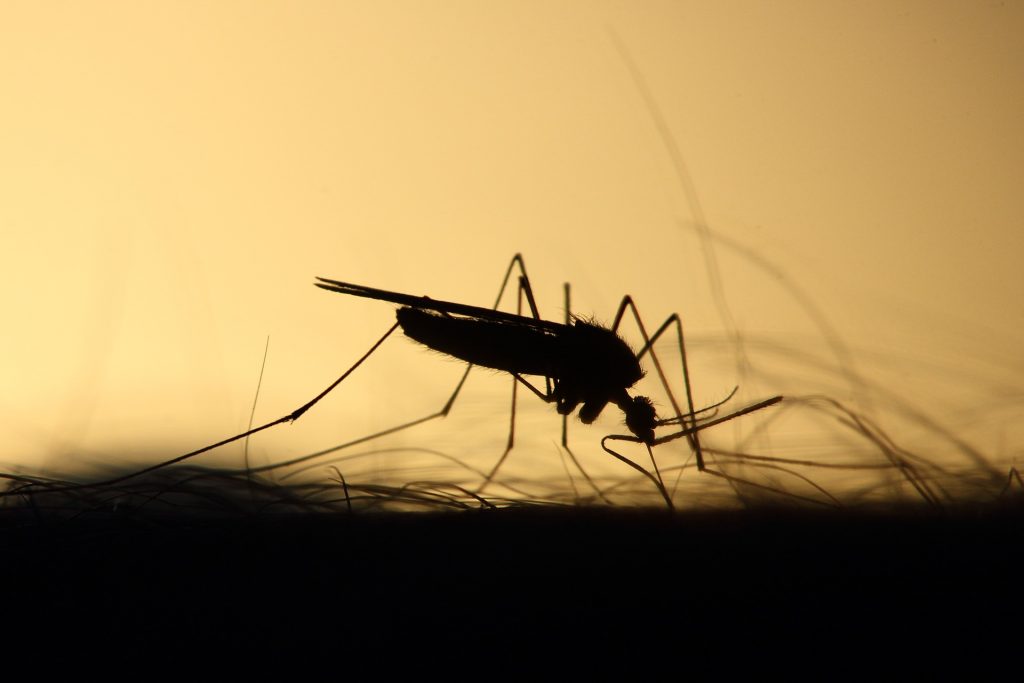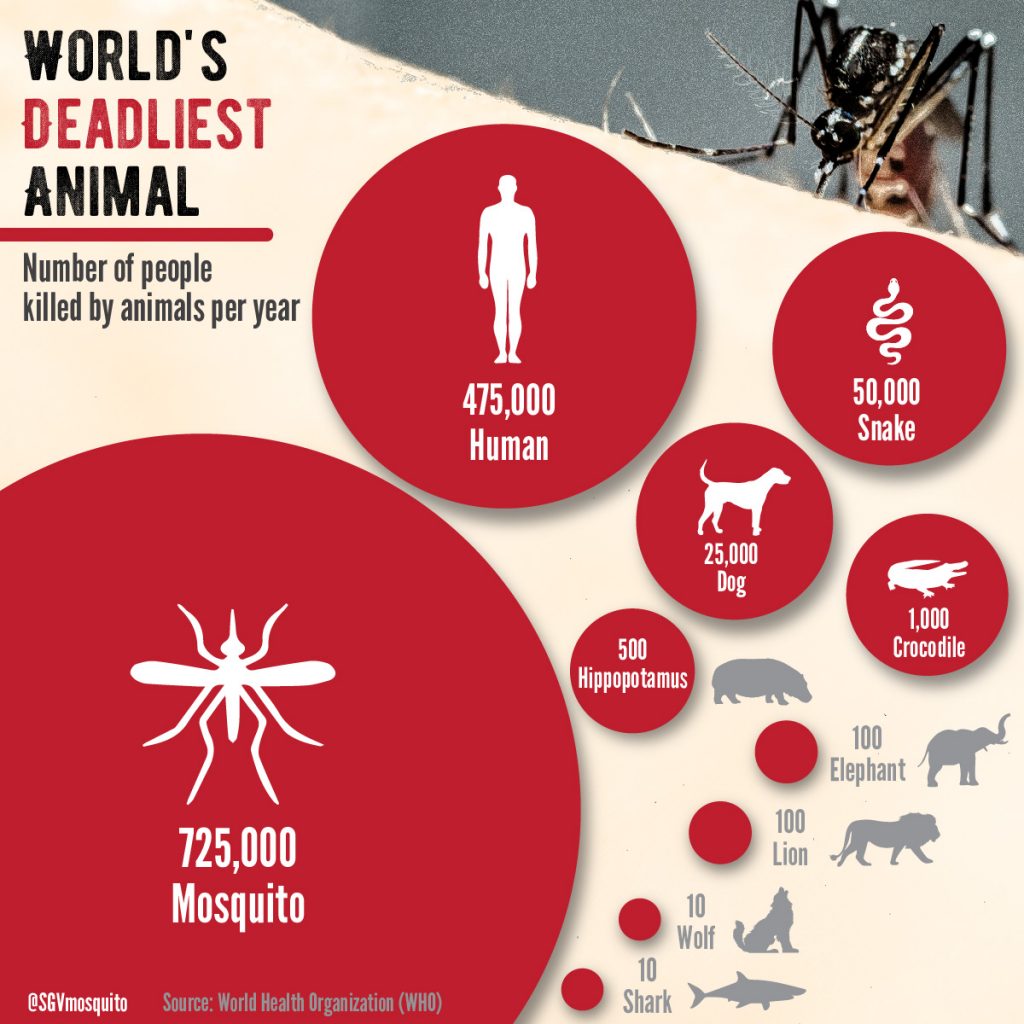
Mosquitoes are very small, but not to be underestimated. They cause great damage worldwide, because the viruses and diseases they spread cause thousands of deaths of humans every year. It is therefore important for us to take a closer look at these insects and explain how to protect yourself against them.
What are the benefits of mosquitoes?
We find mosquitoes annoying and disruptive, but these bloodsuckers play an important role in the ecosystem and even for human health.
- Mosquitoes are an important source of food for many creatures, such as birds, spiders and fish.
- Every bite of these insects also has something good, because the itchy bites keep our immune system fit and upright. Without mosquito bites and other challenging influences our body would eventually be underchallenged, so that allergies can develop.1
- Mosquitoes are also important pollinators, so plants depend on their work. For example, cocoa plants and farmers are also dependent on the pollination of biting midges or gnats.2
- The parasites also keep the population numbers of their host animals within limits, which means that their host animals cannot spread unhindered because the parasites make life difficult for them.3
What dangers does the mosquito pose to humans?
When we think of deadly animals, we think more of sharks or snakes. But the deadliest animal in the world, measured by how many people it kills every year, is by far the mosquito. Mosquitoes kill at least 725,000 people every year. What makes them so dangerous is their ability to transmit viruses or parasites that cause devastating diseases. (Humans are on second place directly behind mosquitoes, causing 475,000 deaths a year.)4

In tropical countries, some mosquito species cause fear and terror. In many regions of the world, humans are exposed to numerous pathogens that can be transmitted by these insects.
Throughout the EU, mosquitoes are more annoying and less dangerous, but climate change has already led to cases where people have contracted or died of viruses as a result of the introduction of dangerous species. For example, in Greece, West Nile virus infections have occurred with 50 deaths last year5 and in France, the first case of dengue fever has recently been reported.6
In Germany, the first tropical mosquito was discovered in 2007, since then more and more small populations have been forming every year.7 And a few days ago, the Asian tiger mosquito was even discovered for the first time in Geneva (Switzerland).8
The characteristics and properties of mosquitoes
There are about 3,500 species of mosquitoes in the world and only a small proportion of them seriously threaten human health. The male mosquito feeds exclusively on plant juices and nectar and thus also contribute to flower pollination. Only the female mosquito needs an additional protein-rich blood meal and bite warm-blooded creatures (animals and humans) to be able to produce eggs.9
Many mosquitoes lay their eggs on the surface of fresh or stagnant water. The water can be found in tin cans, barrels, ornamental ponds, puddles, streams or swampy areas. It is optimal if the water is protected from the wind by grass and weeds. Within 24-48 hours, tiny mosquito larvae develop from the eggs.
Depending on the water temperature, mosquito larvae live 4 to 14 days in the water. Larvae of almost all species have to come to the surface at frequent intervals to get oxygen through their breathing tube, the so-called siphon. They feed constantly, as maturation requires a lot of energy and food. Algae, plankton, fungi and bacteria as well as other microorganisms are part of their diet. During growth, the larva molt four times, after which it becomes a pupa.
The mosquito pupae live 1 to 4 days in the water, depending on type and temperature. The pupa is light and floats on the water surface. If it is disturbed, it dives for protection with a jerky movement and then swims back to the surface. The pupa is the last step in its development, the metamorphosis of the mosquito into an adult is thus completed. The adult mosquito splits the pupal case and emerges to the surface where it rests until its body has dried and hardened.
Aedes mosquitoes are painful and persistent biters. They look for a blood meal early in the morning, at dusk and in the evening. Some are diurnal (active throughout the day), especially on cloudy days and in shady areas. They usually do not enter homes and prefer to sting mammals such as humans. Aedes mosquitoes are strong flyers and are known to fly many miles away from their larval development sites.
Culex mosquitoes are also painful and persistent biters, but they prefer to attack at dusk and in the dark. They like to enter homes for blood meals. They are generally weak flyers and do not move far from their home, although they are known to fly up to about 3 kilometers. Culex usually live only a few weeks in the warm summer months. The females, which appear in late summer, look for protected areas, in which they spend the winter until spring. Warm weather brings them out again in search of water on which they can lay their eggs.10
When a mosquito bites a person to take in its food, it injects a glandular secretion into its victim through its sucking trunk. This secretion serves to prevent blood coagulation during feeding and at the same time increases blood flow to the injection site. The mosquito’s saliva may contain various pathogens such as bacteria, viruses or other parasites that the mosquito has ingested from an infected victim during previous feeding.
Here we describe the most important mosquitoes in more detail:
Common mosquito (Culex pipiens)
It is known and spread all over the world. The mosquito is about 3-7 mm in size, has a slender body, narrow wings and legs. The abdomen is dark brown with white stripes. It is harmless, but very annoying as its stings cause itching and redness.
Asian tiger mosquito (Aedes albopictus)
Diseases: Malaria, Yellow fever, Zika virus, Chikkungunya virus, Dengue fever, West Nile Virus.
Their home is the South and Southeast Asian region. The mosquito grows between 2 and 10 mm in size and quickly adapts to new conditions. Climate change therefore also enables it to open up new regions. The tiger mosquito is easy to recognize due to its white stripes on the body and legs.
Malaria mosquito (Anopheles)
Diseases: Malaria
This mosquito is found on all continents. It can be easily recognized by the special figure and shape of its back shield. It is round and has a row of bristles.11
Yellow fever mosquito (Aedes aegypti)
Diseases: Yellow fever, Zika virus, Chikungunya virus, Dengue fever
This mosquito comes from the tropics and subtropics, is very small (3-4 mm) and has a dark coloured body with white stripes on the legs. The yellow fever mosquito likes it very warm and can already be found in Europe, southern Spain, Greece and Turkey.
Asian bush mosquito (Aedes japonicus)
Diseases: West Nile virus, Meningitis
It originates from the south of China, Japan and Korea and was introduced to Europe, similar to the Asian tiger mosquito. Optically it resembles the Asian tiger mosquito, has a black body colour and silvery-white stripes.12
The identification of mosquitoes is not always easy for the layperson, the insects are not only very small, but also fast and often sting without us noticing.
Prevention with Bio/Clean Kill
During the warm summer months, a simple fly screen in front of the window is not always sufficient, so we recommend the use of BIO/CLEAN KILL to protect yourself against all types of mosquitoes.
BIO/ CLEAN KILL contains the active ingredient Permethrin. This is also used to treat mosquito nets and impregnate clothing. So, the application can also provide a repellent effect when applied to areas.
Applying BIO/CLEAN KILL Classic every few weeks in spring and summer in the house by spraying cracks, joints and corners on the walls, as well as windows, fly screens and curtains helps to effectively protect yourself against possible intruders.
BIO/CLEAN KILL Extra micro-fast can also be applied around the house. Spray all areas where mosquitoes are present extensively until they are well moist – do not spray wet so that it drips!
Market specific: If Bio/Clean Kill Extra micro-fast is not available (blue label), please use Bio/Clean Kill Original or Classic (green label).
Why are we actually being stung?
In order to find their victims, mosquitoes orient themselves on the gas carbon dioxide, which they can perceive or smell from up to 50 meters away. Since humans and animals exhale carbon dioxide, they are very easy prey. The more gas there is in the breath, the more attractive the victim is for the mosquito.
There are, however, other assumptions as to why some people are bitten more or less often. One of them is that the blood type also plays a role. Scientists from Japan have determined through testing that people with the blood group 0 are particularly favoured by mosquitoes. But how do mosquitoes know what blood group a person has? Here their research concluded that 85% of all people show this via a certain chemical signal on their skin. The other 15% who do not “emit” this signal should be left alone by mosquitoes.13
Scientific tests or not, it will probably remain a mystery why some people are more or less attractive to these little bloodsuckers. It is important that you protect yourself. Especially if you are planning a trip to affected countries, you should inform yourself well.

Click here to see WORLD OF MOSQUITOES – REFERENCES